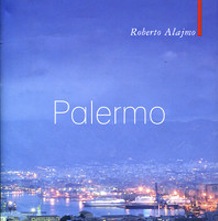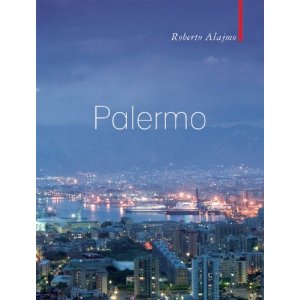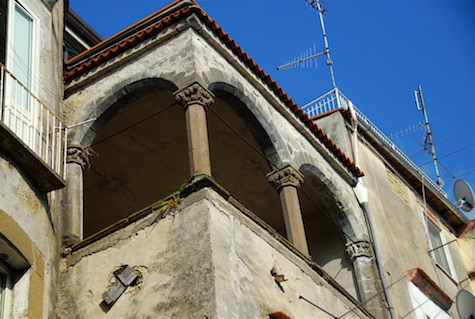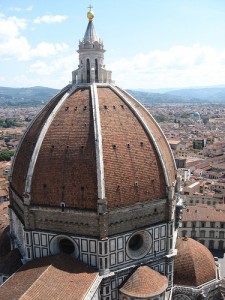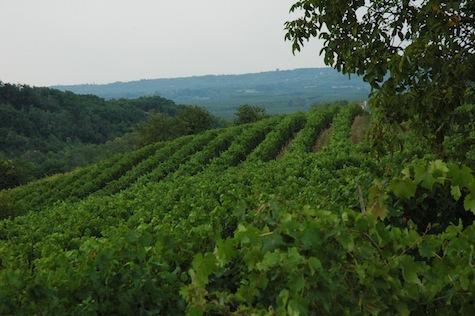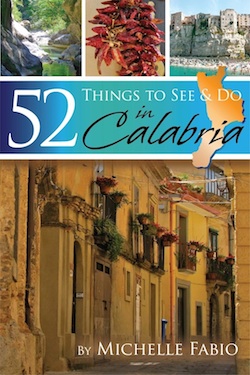Author Archive
Palermo by Roberto Alajmo
 If you’ve been to Palermo in Sicily, you probably either loved or hated it. My love for the city is no secret. Palermo is not a place that throws open her arms to you; she makes you work for it, makes you discover her charm one ridiculously busy street at a time — and I tend to like that in cities. See also: Philadelphia.
If you’ve been to Palermo in Sicily, you probably either loved or hated it. My love for the city is no secret. Palermo is not a place that throws open her arms to you; she makes you work for it, makes you discover her charm one ridiculously busy street at a time — and I tend to like that in cities. See also: Philadelphia.
I’ve written a series of posts about some of my favorite popular stops in Palermo including the Duomo, Fountain of Shame, Antica Focacceria San Francesco, and the Capuchin Catacombs, so when I got an offer to review Roberto Alajmo’s new book Palermo from Haus Publishing, I jumped at the chance. The fact that it fits in perfectly with the Gita Italiana 2010 is like icing on the cannoli. Or something like that.
Roberto Alajmo is a native of Palermo; this book is translated into English by Guido Waldman. When I received it, the first thought in my mind was whether this was going to be a love letter to the gritty Sicilian città probably known best for the Mafia and its pastries — and I’d say yes. Yes it is, but it’s a palermitano love letter, if you will.
Now let me explain.
Alajmo speaks directly to a first-time visitor to his city from the first sentence: “You have to get yourself a window-seat and arrive on a clear sunny day.” This sets the tone of the entire book as he educates the reader about the city’s sights, but not just tourist attractions. Much of the book is a tongue-in-cheek look at the city and its natives with caustic, wry observations about illegal structures, Palermitano mentality about corruption, rubbish, politics, and so much more.
I found myself smirking through most of Palermo (and underlining an overwhelming portion of the book) because Alajmo’s analysis is so keen, his criticism subtle and yet full of daggers. He leaves you with many thought-provoking ideas such as the real reason why the South has so many unfinished buildings: “an unconscious sense that total completion carries with it an inbuilt sorrow.” It’s just a brilliantly written book.
So where’s the love?
Remember, Alajmo is a native of the city. He knows it. He appreciates its beauty, but he really delves into its problems — *big* problems in many instances — and the latter is what nearly all of this book is about. But in order to truly love someone (or in this case, something), don’t you have to recognize the faults and decide to love anyway?
So, yes, I would characterize Alajmo’s Palermo as a love letter to his city — a whopping, entertaining dose of tough love, but would a Palermitano have it any other way? I just loved it. Five very full espresso cups out of five.
Aside from content, by the way, this is simply a snazzy little book. It’s hardcover and measures 15.6 x 11.6 cm (about 6 x 5 inches); perfect for stuffing in your bag on a trip and a great gift item as well.
Have you been to Palermo? Would you like to go?
*
Subscribe to my Book Reviews feed — book reviews ONLY, which aren’t published to the main feed — by visiting Feedburner.
Gita Italiana 2010: The Loggia
 Today’s stop on the Gita Italiana 2010 is in Campania, and our guide is Karen Wolf of The Shock of the Old. Welcome Karen!
Today’s stop on the Gita Italiana 2010 is in Campania, and our guide is Karen Wolf of The Shock of the Old. Welcome Karen!
The Loggia
1.
‘Returning to the principal street, one can see, in the courtyard of Palazzo Polito, a cylindrical tower with a sloping base dating to the Aragonese period, flanked by a Catalan loggia with polygonal pilasters and foliate capitals carved from tuff, built upon the medieval ring wall…’ (Antonio Marcello Villucci, Sessa Aurunca: Storia ed Arte, Marina di Minturno: 1995, p.87)
2.
When I came to Sessa Aurunca to marry my husband, I moved into a house filled with a great assortment of books. I appropriated them all, filing them in amongst my own, and as I read them, I annotated their margins in pencil, marking them as mine. Among these new acquisitions was a slim volume by one Antonio Marcello Villucci, an introduction to the history and art of Sessa Aurunca, presented in the form of a walking tour. In the beginning I used it as a work of reference, flipping through its pages to find illustrations of things I had encountered on my walks around town, and scanning the accompanying text for names and dates. Later, when there were no new streets or alleys left to explore, it became something of a treasure map, directing me to the few remaining sights I had somehow overlooked. The last of these was a loggia, in the Catalan style, and the caption beneath its picture told me to look for it at Corso Lucilio, no. 98.
3.
On the Corso, the numeri civici followed a palimpsestic logic. They skipped and stopped and started again. Some buildings had no numbers at all, others as many as three. They were stenciled in red, or black or orange, or painted in blue on white ceramic tiles. Odd numbers lined one side of the street, and even numbers the other, except in the places where they appeared together. They suggested an urban history full of modifications and restorations but they did not lead me to the loggia. For weeks I parsed the architecture of the Corso for clues to its location. I examined windows and arches, and guessed at the thickness of walls. I peered into courtyards through open doors, looking for the loggia or any hint of its Catalan style. From one day to the next, these portals opened and closed, as though in a game of musical doors, or memory. I began to wonder whether the loggia was hidden behind a door that remained forever locked, or if I had simply missed every opportunity to chance upon it.
4.
One morning, months after I had abandoned my search for the loggia, I pushed my daughter in her stroller past a stone portal that I was sure I had never seen before, although its great size made me wonder if that were possible. Its arch opened onto a wide, barrel-vaulted passageway, and just beyond that was a small white-washed courtyard where a flight of stairs led to a mezzanine on the first floor. Unable to account for the feeling I had that the loggia was near, I shrugged it off and continued on our way.
A couple of weeks later, an errand took us to the same stretch of the Corso. I stared into the white courtyard as I wheeled my daughter past it. A few doors down, I paused, and sensing once again the presence of the loggia, I retraced my steps. In the barrel-vaulted corridor, I noticed a massive wooden door leaning on its long edge against a wall. From the foot of the stairs, I looked up at the mezzanine. Following it around the walls with my eyes, I turned my head to the right and noticed that the white courtyard opened onto another, much larger one. Along its far side was a tall, nondescript apartment house, and to the left and right, two rows of garages, their doors painted green.
“Where are we going, Mommy?” my daughter asked.
“Home, baby. There’s nothing here,” I told her.
5.
On the night of Pasquetta, we descended the Corso under glimmering, golden lights. We passed the candle-lit church of San Giovanni in Piazza and then the palazzo where twice before I had sought the loggia. In the quiet calm of the darkened street, I sensed the town speaking to me with a golden resonance. “Can we go in there for a minute?” I asked my husband, indicating the great stone arch.
‘What is this place?’ he wondered aloud once we had entered white courtyard.
“Wait here,” I told him, “I think I’m about to find what I’ve been looking for.”
I walked into the darkness of the second courtyard and turned slowly to face the entrance. Raising my hand to shade my eyes from the light shining beyond the arch, I perceived, directly to the right of it, the mass of a cylindrical tower, and as my vision adjusted to the darkness, the profile of the loggia.
*
Karen Wolf is an art historian living in the Campania region of southern Italy. When she’s not on the hunt for architectural treasure, she blogs as KC at The Shock of the Old.
Gita Italiana 2010: Taking a Break, Italian Style
 Today’s featured Gita Italiana writer is Julie Angelos of Jbulie’s Blog, who gives us a little background on what happens in August in Italy and a few ideas on where to go.
Today’s featured Gita Italiana writer is Julie Angelos of Jbulie’s Blog, who gives us a little background on what happens in August in Italy and a few ideas on where to go.
Welcome Julie!
Taking A Break, Italian Style
Ferie d’Agosto (Ferragosto) is an Italian national holiday on August 15th when all stores are closed and most people head to the coasts or the mountains.
The actual date happens to coincide with my best friend’s birthday so it makes it easy for me to remember. I was actually shocked and surprised my first year living in Italy that nearly ALL of Italy closes for August. I don’t mean all of August, just that almost ALL Italians take a holiday in August somewhere.
I’m certain that this is due to the heat and the fact that schools are closed. I did a little investigative research the first year I moved here by asking my Italian friends where and when they were going. What I got was all over the world that included Thailand, Mexico, the coast, Sardinia, Sicily, U.S.A, France, England ~ just about anywhere actually.
Most Italians take a couple weeks of vacation from 10 days to as much as 60. Well, I took 58. Does that count? I’m also known to go overboard. Unfortunately, airline prices rise accordingly making the high season tickets double the low season fares.
I live just outside of Bologna which is an hour north of Florence, and a couple hours by train or car south of Venice and Milan. It’s considered northern Italy, although I feel like it’s quite centrally located. I remember reading somewhere that ninety percent of trains in Italy pass through Bologna.
In August, the streets become suddenly empty. All of the stores pull down their rolling metallic doors to lock them up. The newspaper prints an article on the stores that are OPEN instead of closed. Transport is limited or toned down. Car traffic is pretty grueling.
Where to go?
My favorite getaways in Italy are Venice, Florence, Assisi, the Lakes and Cinque Terre. A lot of people like to go up to the mountains to get away from the heat. I lived a year in Florence and that city still is on my top beautiful cities in the world together with Paris and San Francisco.
Maybe you have heard about Stendhal’s syndrome?
What happens is this: you are walking through one of the most magnificent historic city centers in the world when all of a sudden a small square opens up to reveal the big beautiful cathedral called the Duomo with its glorious cappello designed by Brunelleschi. I don’t know if you’ve ever seen it, but for me and my friends it was a jaw-dropping experience.
I felt I was looking at all of humanity’s compassion and ability wrapped in pretty tri-colored marble ribbon. Don’t get me wrong, there is no bow or ribbon on the Duomo; it’s just a metaphor to describe a pretty present left to posterity. One word of caution, though: one year while walking around Florence in August, my girlfriend refused to come with me. Too hot, she said. She might have been right.
Wherever you decide to travel in August, I like to remember that it’s always nice to get away, yet it’s always nice to come back home too.
*
Julie Angelos is a teacher and writer who moved to Italy on a whim when she was 30 and still lives here with her husband and two sons. You can find her at Jbulie’s blog and @jbuliesblog on Twitter.
Gita Italiana 2010: Mountains & Sea: Between Two Worlds on Italy’s Amalfi Coast
 Next stop on the Gita Italiana 2010 is one of the most popular parts of Italy — and rightfully so judging from these photos and words! Here comes Laura of Ciao Amalfi!
Next stop on the Gita Italiana 2010 is one of the most popular parts of Italy — and rightfully so judging from these photos and words! Here comes Laura of Ciao Amalfi!
Mountains & Sea: Between Two Worlds on Italy’s Amalfi Coast
Postcard images of seaside villages with pastel houses climbing up steep mountainsides, rocky beaches with unimaginably blue waters, beaches lined with brightly colored umbrellas—these are the picturesque images that define Italy’s Amalfi Coast. Those of you that have visited this beautiful part of Italy will agree with me when I say that it’s even more extraordinary than any photograph could possibly capture.
The mountains soar—rocky edges outlined against the blue sky— forming a seemingly unreal backdrop high above the famous seaside towns of Amalfi and Positano. The Lattari Mountains form the backbone running down the Sorrento Peninsula separating the southern coastline, called the Amalfi Coast, from the northern coastline on the Bay of Naples. Home to wild boars and rare plant species, these mountains are lush, rich and mysterious. They are the other side of the Amalfi Coast – a landscape of strong contrasts where the scent of pine trees lingers in the fresh, salty breeze.
When winter storms come rolling in, they cling to the top of those mountains as if afraid to continue out to sea. Yet, the sea welcomes those mountains, with sharp edges plunging into the blue waters. Somewhere in between, the sea and the mountains meet to create the unique landscape and lifestyle of the Amalfi Coast.
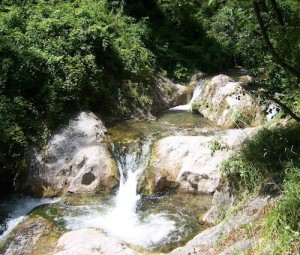 High above Amalfi, the Valle dei Mulini (Valley of the Mills) climbs into a magical and completely unexpected mountain landscape. Hiking up from the center of Amalfi, you soon pass the ruins of the town’s once thriving paper mills, which supplied fine quality paper all over southern Italy in the Middle Ages. Soon you enter another world, where pure, ice cold water from the high mountain source rushes through little pools. Then you’ll reach a point where the waterfalls bring to mind tropical rainforests rather than the rugged Amalfi Coast. At that moment the nearby sea and rocky beaches seem a world away.
High above Amalfi, the Valle dei Mulini (Valley of the Mills) climbs into a magical and completely unexpected mountain landscape. Hiking up from the center of Amalfi, you soon pass the ruins of the town’s once thriving paper mills, which supplied fine quality paper all over southern Italy in the Middle Ages. Soon you enter another world, where pure, ice cold water from the high mountain source rushes through little pools. Then you’ll reach a point where the waterfalls bring to mind tropical rainforests rather than the rugged Amalfi Coast. At that moment the nearby sea and rocky beaches seem a world away.
These two sides of the Amalfi Coast are also represented in the regional cuisine. In the villages along the sea, specialties are based on mare (sea) and the abundant seafood, while up the mountains you’re more likely to find dishes based on terra (earth). As you drive higher in the mountains to the villages of Scala, Ravello and Tramonti, you’ll find a landscape covered with chestnut trees and traditional dishes featuring salsicce and locally foraged funghi.
When people ask me for advice for visiting this beautiful part of Italy, I encourage them to try to experience both sides of the Amalfi Coast. Spend time swimming in the incredible waters and looking up at the towering mountain backdrop. But, if you have time, get up in the mountains, go hiking and experience the other side of the Amalfi Coast. For me, I feel as if I truly began to understand the Amalfi Coast’s beauty, culture and lifestyle when I began to explore the mountains and looked down on the tiny villages overlooking the Mediterranean Sea.
*
Laura Thayer is an art historian and freelance writer living on the Amalfi Coast in Italy. She is currently co-writing a novel set in Italy with her mother and writes about life on the Amalfi Coast at her website Ciao Amalfi. Photos © Laura Thayer, Ciao Amalfi!
*
Grazie mille Laura!
Tomorrow we’ll be headed to Florence, so be sure to come back!
Gita Italiana 2010: Piemonte: Beautiful, Colorful and Tough
 For the next stop in the Gita Italiana 2010, we’re heading up to visit with Diana Strinati Baur of DianaBaur.com in beautiful Piemonte.
For the next stop in the Gita Italiana 2010, we’re heading up to visit with Diana Strinati Baur of DianaBaur.com in beautiful Piemonte.
Piemonte: Beautiful, Colorful and Tough
I was in a funky little shoe store in Genoa awhile back. The girl that was helping me, a sweet little pea who had clearly spent every non-working, non-sleeping hour perfecting her tan on the beach in Nervi, asked where I came from. I told her that I was American, but living in southern Piemonte. Her eyes widened.
“Che duro,” That’s tough, she responded. I looked at her in surprise. Had she ever been there? After all, it’s only an hour from Genoa, the town where I live. “Mai!” never – with a an expression that clearly said to me, now why would I ever in a million years go there?
It’s funny how little people really know about where I live. Italians often see Piemonte as the North Pole of Italy, because it’s surrounded by snow-covered Alps. They see it as remote, save Torino, where so many from the central and southern parts of the country once came to work for Fiat, in the days when the company had over one hundred thousand workers from all over the boot.
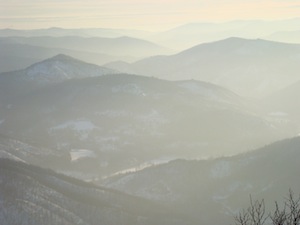 Non-Italians often only associate one thing with Piemonte – Barolo. And often, it’s knowledge from a safe distance – Barolo is a wine with its price and for which a great deal of time and trial must be invested to truly understand and appreciate.
Non-Italians often only associate one thing with Piemonte – Barolo. And often, it’s knowledge from a safe distance – Barolo is a wine with its price and for which a great deal of time and trial must be invested to truly understand and appreciate.
Of course, none of these paradigms begin to do Piemonte justice. To begin to understand what Piemonte is, it’s actually easier to start with the short list of what Piemonte is not.
Piemonte is not the beach. Unlike so many Italian regions, not a lick of salt water touches Piemonte’s borders. If it’s sandy Mediterranean or Adriatic coastline you are looking for, you would be better off looking elsewhere.
Piemonte is not Renaissance or Baroque Art. Please, oh, please don’t come here looking for Caravaggio or DaVinci. If we have any of these works of art, they are usually on loan from Florence or Rome.
Ok, now that that’s handled we can finally get to what Piemonte actually is.
Piemonte is stunningly beautiful. Ok, this might seem like a subjective statement, but the truth is that the ocean is the only thing we don’t have. We have beautiful lakes, Orta and Maggiore, that are surrounded by the western portion of the Alps (also part of the Piemontese landscape). The Lake Region is a combination of hip, historic, traditional and overwhelmingly majestic.
 Speaking of the Alps, the Gran Parco Paradiso is in the shared regions of Piemonte and Val d’Aosta. A short ride from the flatlands of Cuneo will bring you to Limone Piemonte, where the skiing is great and the views are even better. Valle di Susa and Sestriere, Bardoneccia and many other famous ski resorts are all within Piemonte’s borders.
Speaking of the Alps, the Gran Parco Paradiso is in the shared regions of Piemonte and Val d’Aosta. A short ride from the flatlands of Cuneo will bring you to Limone Piemonte, where the skiing is great and the views are even better. Valle di Susa and Sestriere, Bardoneccia and many other famous ski resorts are all within Piemonte’s borders.
But of course, the most beautiful part to me is where I live, the wine country. We have over 70,000 hectars of vineyard, with over half of them registered as either DOC or DOCG (the largest DOC land registration in Italy). We have vast kiwi, hazelnut, walnut and cherry plantations. The geographic makeup of Piemonte is mixed agricultural combined with woodland, a fact that helps make it so beautiful.
Piemonte is the best food in the country. Ok. Relax, Umbria and Emilia Romagna. You too, Sicily. But seriously, this area takes the best of what Italy and France has to offer, spins the two together and produces some of the most amazing flavor combinations imaginable. It also helps that the selection of over 39 DOC wines to choose from. As the great Marcella Hazan states on her website Made In Italy:
Great wines come from (Piemonte) and it’s not a coincidence that the land that produces a great wine also produces a great cuisine.
Piemonte is part of the economic heart of Italy. It produces 8.4% of the country’s national wealth, is the cradle of the country’s auto production and invests 1.8% of its GDP back into innovation and science every year.
Piemonte is stylish and sophisticated. People often are shocked on their first visit to Torino. They somehow expect an industrial backwater. What they find is a city that is more European than strictly Italian, with fabulous shopping arcades, a gorgeous river promenade, great museums, a lively University district, great restaurants, and perhaps the most interesting café culture outside of Paris.
That sophistication trickles down to all of the smaller cities. Alba, heart of the Langhe wine region, has a wonderful pedestrian shopping district with local products and designers; the same can be said for Alessandria, Acqui Terme, Asti, Verbania, Stresa, Novara, Casale Monferrato, Cuneo and a myriad of other large towns that boast a cultured and colorful lifestyle.
Piemonte is the home of the first Italian. Piemonte is the birthplace of Italy as a singular nation. Count Camillo Benso di Cavour, who designed the contitutional structure for a unified Italian state, and for whom every town in the country has a street named, was Piemontese. Another notable street-name-worthy Piemontese: Vittorio Emmanuele II, the first King of Unified Italy.
Piemonte is close to France and Switzerland. This is not only handy for me, as a bed and breakfast owner catering to an international audience, but it’s handy for Piemonte as well, since it means that the region has a definite international flair. Our dialect reflects our proximity to France, as does our cuisine. The region is steeped in Napoleonic and Savoy history.
In short, with the exception of just a couple of details, Piemonte is what Italy is. Colorful. Strong. Proud. And yes, it’s sometimes tough as well. But that invariably comes with the territory and the culture of a land rich in tradition and history.
*
 Diana Strinati Baur is an American writer, artist, life coach and innkeeper living and working in Northwestern Italy. In 2003, she and her husband sold everything and bought an abandoned Moscato farm in Acqui Terme, Piemonte, Italy, transforming the derelict property into an elegant, top rated bed and breakfast. She used her day journals as the basis of her first blog, and has written two books: Your Truth – Changing the Path Back To Yourself, a self-published ebook about embracing risk and life change as a motor for personal growth, and True Vines, a novel to be published by Gemelli Press in October of 2012. Diana sells her hand crafted ceramics internationally.
Diana Strinati Baur is an American writer, artist, life coach and innkeeper living and working in Northwestern Italy. In 2003, she and her husband sold everything and bought an abandoned Moscato farm in Acqui Terme, Piemonte, Italy, transforming the derelict property into an elegant, top rated bed and breakfast. She used her day journals as the basis of her first blog, and has written two books: Your Truth – Changing the Path Back To Yourself, a self-published ebook about embracing risk and life change as a motor for personal growth, and True Vines, a novel to be published by Gemelli Press in October of 2012. Diana sells her hand crafted ceramics internationally.
Photos © Diana Baur.
*
Grazie mille Diana!
Tomorrow we’re headed south to the Amalfi Coast, so please come back!

